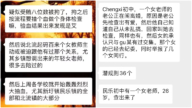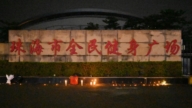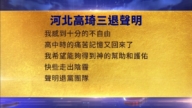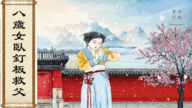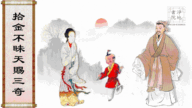【新唐人2013年12月11日讯】一部中国历史题材的电影《大明劫》,近期热爆大陆影视评论界。影片讲述明朝末年,崇祯皇帝启用名将、名医挽救内忧外患、瘟疫蔓延的大明王朝,最后终以失败告终。评论认为,片中影射了穷途末路的中共政权,警示中共“瘟疫可治,人心难收”。
《大明劫》是由留美海归人士谢晓东编剧、青年导演王竞执导的历史题材影片。影片描述1642年明朝末年,全国瘟疫横行,战乱四起,崇祯皇帝把关在死牢的名将孙传庭释放,令他率兵征讨农民军领袖李自成。
《大明劫》10月25号,在中国大陆戏院首映,立即引来了各个影片网站的热播,北京、广州和深圳等街头则出现了DVD版。因片中故事的时代背景与当今中国社会相似,片中情节与人物言行,令观众联想到时下的中共,甚至“对号入座”引起强烈共鸣。
有评论质疑,这样一部借古喻今,影射中共政权穷途末路的影片,是如何通过电影管理部门审查的?也有评论称赞创作者高明,把真实历史和艺术创造巧妙结合,使审查者无可挑剔。还有评论则认为,这部影片通过了中共文宣的审查乃是“天意”。
时事评论员石静笛:“其实任何朝代在退出历史舞台的时候,那个阶段社会的状况,都有很大的相似性的,贪官污吏遍地、严刑峻法镇压、民不聊生、瘟疫流行等等,所以与其说,这部电影是借古喻今,不如说这是历史在给现在的上课。”
影片中记述,名将孙传庭率兵征讨农民起义军,可军饷不济,军营内瘟疫蔓延,军营外的村民也因为瘟疫几乎死绝。
当名医吴又可赶往军营告诉赵提领瘟疫传染的原因时,赵提领因在军中治疫无效,已被“指挥史”杀害。吴又可让“指挥史”告知全城百姓,大瘟疫将至,务必人人小心。但“指挥史”一听,勃然大怒,骂道,如此一来岂不军心大乱。
由于赵提领封锁消息,随后军营中死亡者倍增。网民指出,这像极了2003年中国“非典”疫情爆发时,中共为了粉饰太平,封锁消息的情形。
影片中还描述,当国库空虚,钱粮紧缺时,孙传庭要到“经历司”查账,追缴官吏们多年来囤积的钱和粮,但“经历司”一夜间被一场大火烧掉了,官吏们的收支再无从查起。
网民说,这与中共“巡视组”到地方展开工作,“中储粮”、“中储棉”马上发生大火,如出一辙。
石静笛:“政权和民众的关系是‘水可载舟亦可覆舟’,但是像暴秦(秦始皇)、中共以及各个朝代末期,官员们如狼似虎的镇压百姓、盘剥百姓,所以中共走入暴秦结局,也是它们自己的选择。”
香港《苹果日报》指出,这与当今中国社会也十分相似:社会矛盾激化,大规模群体事件此起彼伏,血案冤案不绝。对此,明朝用东厂、西厂,残酷镇压﹔中共则用公安武警维稳。罔顾人权,如出一辙。
前香港《联合报》文艺类专栏作家张成觉指出,现今的中共社会还不如明朝末期,他说,明朝是私有制,民众有私有权。
前香港《联合报》文艺类专栏作家张成觉:“现在的大陆中国它不是私有制的社会,农民是没有自己的土地的,居民他的住房土地也是属于国家的,国家随时可以征用他的土地以及房子,所以现在很多上访的就是为了这个问题嘛。”
张成觉指出,中共执政几十年来,制造大饥荒、大屠杀、文革等,害死八千万中国人,把经济搞垮,把传统文化摧毁,屠杀“六四”学生、迫害法轮功、访民等,早已民心尽失,明朝的灭亡警示中共:瘟疫可治,人心难收。
采访编辑/李韵 后制/陈建铭
Movie “Fall of Ming" Alludes to The CCP’s End
“Fall of Ming" is a Chinese history-themed movie that has
recently won over China’s entertainment critics.
The movie portrays the end of the Ming Dynasty when
Emperor Chongzhen ends in failure in his efforts
to save the dynasty from rebellion and an epidemic,
even with the help of capable generals and doctors.
Commentators say the film alludes to the Chinese communist
regime’s going down a dead end, and warns the regime that
pestilence can be cured, but hearts are hard to reconcile.
“Fall of Ming" is a movie directed by Wang Jing
based on a screenplay by Xie Xiaodong.
It takes viewers back to 1642, when the Ming Dynasty
was troubled with rebels and a rampant epidemic.
Emperor Chongzhen released General Sun Chuanting
from death row and had him lead Ming troops on crusade
against peasant rebel leader Li Zicheng.
“Fall of Ming" premiered in China on Oct. 25.
It quickly became a hit on movie websites and a DVD version
was soon available in Beijing, Guangzhou and Shenzhen.
The film’s plot and characters illustrate a historical theme
resembling contemporary Chinese society, making many
viewers think of China today under the Communist Party.
It has thus had a strong resonance with viewers.
Some critics wondered: How did this film with so many
metaphors alluding to the end of the CCP’s regime
get past the review committee in China?
Others commented: It is a clever film combining both
historical reality and artistic creation.
Therefore, it is impeccable to the reviewers.
Some even called it an act of God that the film passed
review by the CCP’s propaganda department.
Shi Jingdi, commentator: “In fact, the period prior to the end
of any dynasty in history share similar situations, such as
widespread corrupt officials, draconian repression,
prevalence of poverty and diseases, and so forth.
The movie is more a history lesson than a simple metaphor."
The movie showed that as Sun Chuanting was on the crusade,
the army lacked funds and then was hit by an epidemic which
spread within the barracks and wiped out nearly all villagers.
When the doctor Wu Youke rushed to the barracks to inform
doctor Zhao Tiling how the disease was transmitted,
he found Zhao had already been killed for failing to find a cure.
When Wu instead informed the commander to warn everyone
about the epidemic, the commander was enraged,
“This will bring chaos to the troops if revealed".
Deaths quickly enveloped the barracks because the doctor
Zhao Tiling blocked the information about the disease.
Many Chinese netizens recalled when the CCP also blocked
news of the SARS outbreak in China in 2003.
The film also described the fact that when the treasury was low
and the land tax was scarce, Sun Chuanting intended to check
the registrar records to retrieve money and food stored by
local governors.
However, the registrar was caught on fire, and the officials’
balance books were burned without a trace.
Netizens compared that to the fire that broke out at a Chinese
grain storage center and a cotton reserve
when the CCP’s inspection teams
were doing local investigations.
Shi Jingdi: “The relationship between a regime and the
populace is like how ‘water can both carry and capsize a boat’.
Like the tyrannical Qin and the CCP, officials have all
repressed and exploited the people at the end of each dynasty.
The CCP is going towards its end is also its own choice."
Hong Kong-based Apple Daily reports that there is a great
resemblance in the social issues as well.
The ever intensified social conflicts and mass protests
have taken place on a large scale, murder and injustice reach
every corner of China today.
While the Ming Dynasty carried out brutal suppressions
through the security and inspection institutes of the East and
West Factories, the Communist regime employs
the public security and armed forces to maintain stability,
with the same inhuman measures.
Former arts columnist for Hong Kong’s United Daily News
Zhang Cheng-Jue says that today’s Chinese society under the
CCP is worse than that at the end of the Ming Dynasty.
He explains that people had private ownership
during the Ming Dynasty.
Zhang Cheng-Jue, columnist: “Today’s mainland Chinese
don’t have private ownership.
Farmers do not own land. Houses belong to the state.
The state can expropriate the land and homes at will.
That’s the reason why there are so many petitioners nowadays."
Zhang Cheng-Jue says over the decades of CCP rule,
manmade famine, massacre, the Cultural Revolution, etc,
have lead to the deaths of 80 million Chinese people.
The economy was ruined, the traditional culture destroyed,
and innocent people such as the July 4th student movement,
the Falun Gong, and petitioners are persecuted and killed.
The regime has lost the support of the people.
The fall of the Ming dynasty is a warning to the CCP:
Pestilence can be cured, but hearts are hard to reconcile.
Interview & Edit/LiYun Post-Production/ChenJianming


